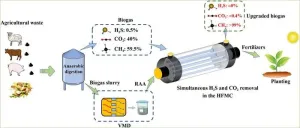(Press-News.org) Cambridge, Mass. — A newly discovered nearby supernova whose star ejected up to a full solar mass of material in the year prior to its explosion is challenging the standard theory of stellar evolution. The new observations are giving astronomers insight into what happens in the final year prior to a star’s death and explosion.
SN 2023ixf is a new Type II supernova discovered in May 2023 by amateur astronomer Kōichi Itagaki of Yamagata, Japan shortly after its progenitor, or origin star, exploded. Located about 20 million light-years away in the Pinwheel Galaxy, SN 2023ixf’s proximity to Earth, the supernova’s extreme brightness, and its young age make it a treasure trove of observable data for scientists studying the death of massive stars in supernova explosions.
Type II or core-collapse supernovae occur when red supergiant stars at least eight times, and up to about 25 times the mass of the Sun, collapse under their own weight and explode. While SN 2023ixf fit the Type II description, followup multi-wavelength observations led by astronomers at the Center for Astrophysics | Harvard & Smithsonian (CfA), and using a wide range of CfA’s telescopes, have revealed new and unexpected behavior.
Within hours of going supernova, core-collapse supernovae produce a flash of light that occurs when the shock wave from the explosion reaches the outer edge of the star. SN 2023ixf, however, produced a light curve that didn’t seem to fit this expected behavior. To better understand SN 2023ixf’s shock breakout, a team of scientists led by CfA postdoctoral fellow Daichi Hiramatsu analyzed data from the 1.5m Tillinghast Telescope, 1.2m telescope, and MMT at the Fred Lawrence Whipple Observatory, a CfA facility located in Arizona, as well as data from the Global Supernova Project— a key project of the Las Cumbres Observatory, NASA’s Neil Gehrels Swift Observatory, and many others. This multi-wavelength study, which was published this week in The Astrophysical Journal Letters, revealed that, in sharp contradiction to expectations and stellar evolution theory, SN 2023ixf’s shock breakout was delayed by several days.
“The delayed shock breakout is direct evidence for the presence of dense material from recent mass loss,” said Hiramatsu, adding that such extreme mass loss is atypical of Type II supernovae. “Our new observations revealed a significant and unexpected amount of mass loss— close to the mass of the Sun— in the final year prior to explosion.”
SN 2023ixf challenges astronomers’ understanding of the evolution of massive stars and the supernovae they become. Although scientists know that core-collapse supernovae are primary origin points for the cosmic formation and evolution of atoms, neutron stars, and black holes, very little is known about the years leading up to stellar explosions. The new observations point to potential instability in the final years of a star’s life, resulting in extreme mass loss. This could be related to the final stages of nuclear burn-off of high-mass elements, like silicon, in the star’s core.
In conjunction with multi-wavelength observations led by Hiramatsu, Edo Berger, professor of astronomy at Harvard and CfA, and Hiramatsu’s advisor, conducted millimeter-wave observations of the supernova using CfA’s Submillimeter Array (SMA) on the summit of Maunakea, Hawai'i. These data, which are published in The Astrophysical Journal Letters, directly tracked the collision between the supernova debris and the dense material lost before the explosion. “SN 2023ixf exploded exactly at the right time,” said Berger. “Only a few days earlier we commenced a new ambitious three-year program to study supernova explosions with the SMA, and this nearby exciting supernova was our first target.”
“The only way to understand how massive stars behave in the final years of their lives up to the point of explosion is to discover supernovae when they are very young, and preferably nearby, and then to study them across multiple wavelengths,” said Berger. ”Using both optical and millimeter telescopes we effectively turned SN 2023ixf into a time machine to reconstruct what its progenitor star was doing up to the moment of its death.”
The supernova discovery itself, and the immediate followup, have significant meaning to astronomers around the world, including those doing science in their own backyards. Itagaki discovered the supernova on May 19, 2023, from his private observatory in Okayama, Japan. Combined data from Itagaki and other amateur astronomers determined the time of the explosion to an accuracy of within two hours, giving professional astronomers at CfA and other observatories a head start in their investigations. CfA astronomers have continued to collaborate with Itagaki on on-going optical observations.
“The partnership between amateur and professional astronomers has a long-standing tradition of success in the supernova field,” said Hiramatsu. “In the case of SN 2023ixf, I received an urgent email from Kōichi Itagaki as soon as he discovered SN 2023ixf. Without this relationship, and Itagaki’s work and dedication, we would have missed the opportunity to gain critical understanding of the evolution of massive stars and their supernova explosions.”
About the Center for Astrophysics | Harvard & Smithsonian
The Center for Astrophysics | Harvard & Smithsonian is a collaboration between Harvard and the Smithsonian designed to ask—and ultimately answer—humanity's greatest unresolved questions about the nature of the universe. The Center for Astrophysics is headquartered in Cambridge, MA, with research facilities across the U.S. and around the world.
END
Extreme weight loss: Star sheds unexpected amounts of mass just before going supernova
2023-09-27
ELSE PRESS RELEASES FROM THIS DATE:
Target: BP™ intitiative helps more than 8.6 million Americans with hypertension improve heart health
2023-09-27
DALLAS, September 27, 2023 — The American Heart Association and American Medical Association (AMA) nationally recognized 1,709 health care organizations (HCOs) — 400 more than in 2022 — for their efforts to prioritize control of their patients’ blood pressure (BP), a leading preventable risk factor for heart disease, stroke and premature death.
According to the 2022 American Heart Association Statistical Update, nearly half of U.S. adults — 121.5 million ...
Tiny CRISPR tool could help shred viruses
2023-09-27
HOUSTON – (Sept. 27, 2023) Small and precise: These are the ideal characteristics for CRISPR systems, the Nobel-prize winning technology used to edit nucleic acids like RNA and DNA.
Rice University scientists have described in detail the three-dimensional structure of one of the smallest known CRISPR-Cas13 systems used to shred or modify RNA and employed their findings to further engineer the tool to improve its precision. According to a study published in Nature Communications, the molecule works differently than other proteins in the same family.
“There are different types of CRISPR systems, and the one ...
Plastic cloud: New study analyzes airborne microplastics in clouds
2023-09-27
Plastic particles less than 5 mm in size are called “microplastics.” These tiny bits of plastic are often found in industrial effluents, or form from the degradation of bulkier plastic waste. Research shows that large amounts of microplastics are ingested or inhaled by humans and animals alike and have been detected in multiple organs such as lung, heart, blood, placenta, and feces. Ten million tons of these plastic bits end up in the ocean, released with the ocean spray, and find their way into the atmosphere. This implies that microplastics may have become an essential component of clouds, ...
Winners of the ASTRO-Sumitomo Pharma-Pfizer Alliance new combination therapy challenge announced
2023-09-27
ARLINGTON, Va., September 27, 2023 — The American Society for Radiation Oncology (ASTRO) today announced the three winning research proposals for the 2022 ASTRO-Myovant Sciences (now known as Sumitomo Pharma)-Pfizer Alliance New Combination (Relugolix-Radiation) Therapy Challenge. The Challenge aims to identify research that addresses ways prostate cancer treatments can be improved with the gonadotropin-releasing hormone (GnRH) receptor antagonist relugolix in patients who received radiation therapy.
The Challenge invited researchers to propose the study of relugolix in different scenarios: ...
New evidence for sub-network specializations within the Default Mode Network and the Special Role of Facial Movements in Brain Activation and Self-Perception
2023-09-27
Recent advancements in neuroscience have unveiled new insights into the neural processes responsible for self-referential cognition. This research has brought particular attention to a critical neural network known as the Default Mode Network (DMN), comprising brain regions such as the medial prefrontal cortex (mPFC), posterior cingulate cortex, temporoparietal junction (TPJ), and both lateral and medial temporal lobes.
Central to self-related processing, is the information associated with one’s ...
Ultrasound enables gene delivery throughout the brain
2023-09-27
HOUSTON – (Sept. 27, 2023) – Rice University researchers tested the safety and feasibility of gene delivery to multiple brain regions using a noninvasive, ultrasound-based technique in rodents, and their findings suggest that the efficiency of gene delivery improves within each targeted site when more sites are opened.
Shirin Nouraein, a doctoral student working in the lab of Rice bioengineer Jerzy Szablowski, is the lead author on the study recently published in the journal Gene Therapy.
The paper, “Acoustically Targeted Noninvasive Gene Therapy in Large Brain Volumes,” ...
Elevating biogas upgrading performance on renewable aqueous ammonia solution via a novel “membrane method”
2023-09-27
Biogas is usually produced by anaerobic digestion of organic waste such as animal manures and straw wastes, which is a typical green renewable energy and can be used as a fuel for power generation and heat production. China has owned large scale of biogas production, with an annual output of about 15 billion m3 biogas, and the biogas development and utilization provide a new choice for coping with the energy crisis. Factually, biogas contains about 60% CH4 and about ...
Golden Goose Award announces 2023 awardees for discoveries in DNA sequencing technique, a bacteria-inspired method that saves crops and chicken pedigree lines
2023-09-27
WASHINGTON, D.C. – The Golden Goose Award, which celebrates federally funded research that sounds silly, but ultimately benefits society, has selected five researchers across the fields of biology, agriculture and genomics for their unexpected breakthroughs as 2023 awardees. On September 27, 2023, the American Association for the Advancement of Science (AAAS), the world’s largest multidisciplinary scientific society, will co-host the 12th annual Golden Goose Award ceremony with the Association of American Universities, a founding member of the Golden Goose Award, at the Library ...
Inventors of nanopore sequencing honored at Library of Congress
2023-09-27
Two UC Santa Cruz researchers were honored on September 27 at the Library of Congress for the invention of nanopore sequencing, which became a new and revolutionary method to read DNA and RNA.
David Deamer and Mark Akeson, both emeritus professors of biomolecular engineering at the Baskin School of Engineering, received the American Association for the Advancement of Science’s (AAAS) Golden Goose Award for the invention. Their colleague and friend Daniel Branton, a Havard biologist and co-inventor of the technology, was also honored.
The Golden Goose award is given to scientists whose federally-funded research ...
Experimental nasal spray may offer quick, easy remedy for treating rapid heartbeat
2023-09-27
Research Highlights:
In a new study, etripamil, a rapid- and short-acting investigational medication formulated to be delivered via nasal spray, restored a normal heart rhythm in less than 30 minutes in most users with intermittent rapid heartbeats, sparing them a trip to the emergency room to receive intravenous medication.
Participants were able to detect when they were experiencing tachycardia (heart rate over 100 beats/minute) and use the medication appropriately and safely.
The self-administered treatment may help the approximately 1 in 300 adults in the U.S. ...









